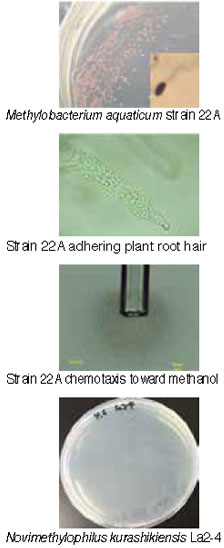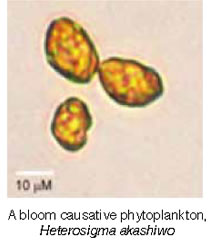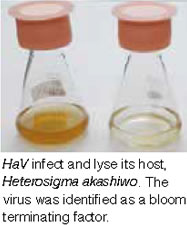Research Area : Plant-Environmental Microbiology
Lanthanide-dependent enzyme and motility in plant-associating methylotrophic bacteria
Plant emit large quantities of methanol through stomata as a result of their growth and pectin degradation. Methanol can be a good nutrient for bacteria and methanol-utilizing (methylotrophic) bacteria predominate on the aerial plant surface (phyllosphere). We focus on their methanol metabolism and symbiosis with plants.
Methylobacterium species are commonly found in phyllosphere, and they can promote plant growth. They have methanol dehydrogenase (MDH) to oxidize methanol. Not only calcium-dependent MDH encoded by mxaF, recently it was found that lanthanide-dependent MDH is also encoded by xoxF in the genomes of Methylobacterium species. This is the first enzyme described to date, to contain lanthanide. We investigate the mechanism of expression switching between these MDHs, depending on the availability of lanthanide.
We also study molecular mechanism of the motility and chemotaxis in methylotrophs, which is important for the bacteria to find and colonize plants. The chemotaxis is also affected by the carbon source and lanthanide.
We have found new methylotrophic bacteria belonging to novel genera. They have been isolated from rice rhizosphere using lanthanide as an essential cofactor. They are named as Oharaeibacter diazotrophicus SM30 and Novimethylophilus kurashikiensis La2-4. Thus, lanthanide can be used for isolation of bacteria that contain xoxF, which can be found in many so-believed non-methylotrophic bacteria and novel bacteria.

Study on dynamics of Phytoplankon in environment
Our group focuses on the study of Heterosigma akashiwo, a unicellular algae that forms harmful algal bloom (commonly termed ‘red tide’) . Algal bloom is typically caused by aberrant propagation of a single species, resulting in its predomination in the local population. While environmental factors including temperature and eutrophication are linked to bloom, the precise mechanism of its formation process is still obscure. We isolated a bacterial strain, Altererythrobacter ishigakiensis, a member of the class Alphaproteobacteria, that promotes growth of Heterosigma akashiwo.This is the first example of selective growth promotion of H. akashiwo by a marine bacterium, and may exemplify importance of symbiotic bacterium on algal bloom forming process in general.

Study on interaction between a giant doube-stranded DNA virus and its host

H. akashiwo bloom is known to be terminated by algicidal bacteria and viruses. Heterosigma akashiwo virus (HaV) was identified as one of such bloom-terminating factors. We completed the sequencing of its genomes. The virual genome was characterized to be a linear double stranded DNA (dsDNA), with an estimated size of ~290 kbp. It is a member of Phycodnaviridae, one of the viral families regarded as “giant dsDNA viruses” that possess genomes larger than several hundred-kbp in size.
We are particularly interested in studying about the infection mechanism of HaV at cellular and molecular level. The study will provide insights into infection strategies of a giant dsDNA virus, and the molecular mechanism of a major environmental phenomenon, bloom termination.



